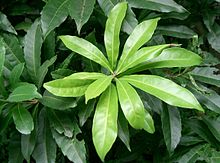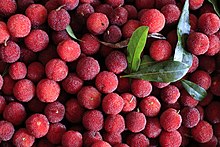Myrica rubra
| Myrica rubra | ||||||||||||
|---|---|---|---|---|---|---|---|---|---|---|---|---|

Myrica rubra |
||||||||||||
| Systematics | ||||||||||||
|
||||||||||||
| Scientific name | ||||||||||||
| Myrica rubra | ||||||||||||
| ( Lour. ) Siebold & Zucc. |
Myrica rubra ( Syn .: Morella rubra Lour. ), Also called poplar plum , is a species of the genus Myrica in the family of the myricaceae . The sweet, purple-red to dark purple-red, edible fruits are used as food . It is mainly native to East Asia and China , but also to Japan and Southeast Asia .
description
Vegetative characteristics
Myrica rubra is an evergreen tree that can reach a height of up to 15 meters and a breast height diameter (BHD) of up to 60 centimeters. The bark of the branches is bare. Its bark is gray. The buds are bare.
The alternate leaves arranged on the branches are divided into a petiole and a leaf blade. The petiole is 2 to 10 millimeters long. The leathery, bald, simple leaf blade is 5 to 14 centimeters long and 1 to 4 centimeters wide and obscured or lanceolate with a wedge-shaped blade base and rounded to pointed or pointed upper end. The leaf margin is completely or in the upper half sawed away, -toothed. The underside of the leaf is pale green and sparsely to moderately covered with golden glands. The upper side of the leaf is dark green.
Inflorescence and flower
The flowering period in China extends from March to April. Myrica rubra is dioeciously segregated ( diocesan ).
The small male inflorescences are simple or inconspicuously branched spikes that stand individually or occasionally in groups of a few inflorescences in the leaf axils. They are 1 to 3 centimeters long, the inflorescence shafts are bare, the bracts are almost circular with a diameter of about 1 millimeter and have golden glands on the underside.
The very small flowers are almost without an inflorescence . The male flowers are accompanied by two to four egg-shaped, sparsely ciliate bracts . Each male flower contains four to six stamens with dark red, elliptical anthers .
The small female inflorescences are single, multi-flowered ears of 0.5 to 1.5 centimeters in length in the leaf axils. The rachis is hairy and glandular. The bracts overlap, are hairless and only inconspicuously glandular. The very small female flowers are accompanied by four bracts. The upper ovary is velvety hairy, with a stylus with a bilobed stigma . The two slender scar lobes are colored bright red.
fruit
When ripe (in China from May to July), the dark red or purple-red, small and fine nubby stone fruit is spherical with a diameter of 1 to 1.5 centimeters; Cultivated plant specimens can produce fruits with a diameter of up to 3 centimeters. The thick-shelled stone core is light brownish, slightly wrinkled and somewhat sculpted.
Chromosome number
The number of chromosomes is 2n = 16.
Occurrence
The distribution area of Myrica rubra extends from the Chinese provinces of Fujian , Guangdong , Guangxi , Guizhou , Hainan , Hunan , Jiangsu , Jiangxi , Sichuan , Yunnan and Zhejiang via Taiwan, Korea to Japan and the Philippines . In China it grows in forests on mountain slopes and in valleys at altitudes of 100 to 1500 meters.
Taxonomy
The first publication took place in 1790 under the name ( Basionym ) Morella rubra by João de Loureiro in Flora Cochinchinensis , 2, page 548. The new combination to Myrica rubra (Lour.) Siebold & Zucc. was in 1846 by Philipp Franz von Siebold and Joseph Gerhard von Zuccarini in treatises of the Bavarian Academy of Sciences. Mathematical and Natural Science Class , Volume 4, Number 3, Page 230 published. More synonyms for Myrica rubra (Lour.) Siebold & Zucc. are: Daphne argyi H.Lév. , Myrica rubra var. Acuminata Nakai .
Most of the species in the genus Myrica sl became the genus Morella Lour by some authors . and therefore Morella rubra would be Lour. again the name to use.
use
Myrica rubra is often cultivated for its fruits. The ripe fruits are edible. They can be preserved in sugar or processed into juices .
The preserved fruits from China are sometimes marketed in Western countries under the name Arbutus . However, this name is apparently confused with the strawberry tree , the fruits of which look very similar to those of the Myrica rubra .
In the Chinese language the fruit is called yangmei ( Chinese 楊梅 / 杨梅 , pinyin yángméi - "poplar plum") and in the Japanese language as yamamomo ( Japanese. 山桃 , kana. や ま も も / ヤ マ モ モ , literally: "mountain peach").
literature
- Anmin Lu, Allan J. Bornstein: Myricaceae. : In: Wu Zheng-yi & Peter H. Raven (Eds.): Flora of China , Volume 4 - Cycadaceae through Fagaceae , Science Press and Missouri Botanical Garden Press, Beijing and St. Louis, 1999, ISBN 0-915279-70 -3 . Myrica rubra Siebold & Zuccarini , p. 276 - online with the same text as the printed work .
- Shiu-ying Hu: Food Plants of China , The Chinese University Press, Hong Kong, 2005, ISBN 962-201-860-2 .
Web links
- as Morella rubra on Useful Tropical Plants.
Individual evidence
- ↑ a b c d e f g h i j k Anmin Lu, Allan J. Bornstein: Myricaceae. : In: Wu Zheng-yi & Peter H. Raven (Eds.): Flora of China , Volume 4 - Cycadaceae through Fagaceae , Science Press and Missouri Botanical Garden Press, Beijing and St. Louis, 1999, ISBN 0-915279-70 -3 . Myrica rubra Siebold & Zuccarini , p. 276 - online with the same text as the printed work .
- ↑ a b Term: "Poplar plum (楊梅 / 杨梅)", Chinese / German: on dict.leo.org. Retrieved September 28, 2017
- ↑ a b Term: "Poplar plum (楊梅 / 杨梅)", Chinese / German: on peter-preus.de - German-Chinese-German dictionary of plants. Retrieved September 28, 2017
- ^ Myrica rubra at Tropicos.org. In: IPCN Chromosome Reports . Missouri Botanical Garden, St. Louis
- ↑ João de Loureiro: Flora Cochinchinensis , 2, 1790, p. 548. scanned at biodiversitylibrary.org .
- ^ Myrica rubra at Tropicos.org. Missouri Botanical Garden, St. Louis, accessed July 28, 2019.
- ↑ Term: " yangmei (楊梅 / 杨梅)", Chinese / English: on zdic.net. Retrieved September 28, 2017
- ↑ a b " Myrica rubra / yangmei / yamamomo ", English: on NCBI Taxonomy Database . Retrieved September 28, 2017
- ↑ Term: " yamamomo (山桃 / 楊梅 / や ま も も)", Japanese / German: on wadoku.de. Retrieved September 28, 2017
- ↑ Term: " yamamomo (山桃 / や ま も も / ヤ マ モ モ)", Japanese / English: on tangorin.com. Retrieved September 28, 2017
- ↑ Term: " yama (山 / や ま) - mountain", Japanese / German: on wadoku.de. Retrieved September 30, 2017
- ↑ Term: " momo (桃 / も も) - peach", Japanese / German: on wadoku.de. Retrieved September 30, 2017



